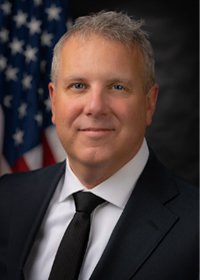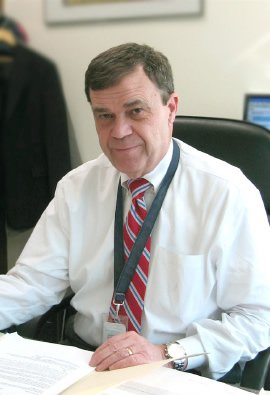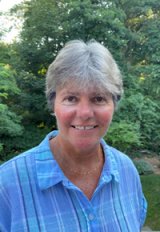2020 Environmental Merit Award Recipients
- A Letter from EPA's Regional Administrator
- Ira Leighton "In Service to States"
- Lifetime Achievement
- Individual
- Government
- Environmental, Community, Academia & Nonprofit
- Business
- Children's Environmental Health
- President's Environmental Youth Award
A Letter from EPA's Regional Administrator

On behalf of EPA Region 1, it is my pleasure to announce the 2020 Environmental Merit Award Winners and congratulate them on their environmental protection accomplishments benefitting communities and ecosystems across New England.
Together, today's honorees include public health and environmental stewards working in every corner of New England. Collectively, initiatives led by these honorees have driven progress toward clean water and clean air, built community support for revitalization investments, sparked environmental innovation, reduced waste, and protected the public from exposure to harmful substances. Through each of their accomplishments, measurable and impactful change has been the direct result of the honorees' dedication, commitment to partnerships, and passion for success.
This year's award celebration looks different from years past, but times of community crisis make it even more vital to come together in any way we can in order to celebrate good news and great stories. As the global pandemic continues to disrupt our communities, highlighting the work of these community champions can serve to remind us of why – when the pandemic is past us – we're always served best when we work together. As such, I am thrilled to be presenting this year's awards to a host of community leaders, scientists, government officials, business leaders, schools, and students who, while representing a diverse array of approaches all share the same commitment to environmental protection.
On behalf of EPA and my colleagues at Region 1, thank you for all the work that you do. We respect and honor the work you do to make a difference in your communities.
Congratulations!
Sincerely,
Dennis Deziel
Regional Administrator, EPA, Region 1

1945-2013
Dedicated EPA public servant since 1972.
A true friend, a mentor and a lover of New England. He is missed.
Ira Leighton "In Service to States" Annual Award
The Ira Leighton "In Service to States" Environmental Merit Award is a tribute to our long-time colleague and friend, Ira Leighton, who passed away in 2013, after serving 41 years at the U.S. EPA. Ira's dedication and passion for protecting the environment was evident to all who knew him. He was a constant presence in New England, a force who took ideas and made them actionable tasks that resulted in measurable improvements.
Initiated by:
- New England Interstate Water Pollution Control Commission (NEIWPCC)
- Northeast States for Coordinated Air Use Management (NESCAUM)
- Northeast Waste Management Officials' Association (NEWMOA)
- New England State Environmental Commissioners
- U.S. Environmental Protection Agency, Region 1 (EPA)
Saluting the Ira Leighton "In Service to States" Annual Award Recipient

Ronald Poltak
The story of Ronald Poltak, who was at the helm of the New England Interstate Water Pollution Control Commission for 37 years until his retirement in 2017, is the story of water quality efforts in the Northeast and nationally.
Ron entered public service in New Hampshire as an intern in the state planning department in 1968 while still an undergraduate at the University of New Hampshire. He returned to the department following active duty in the Air Force, eventually becoming director of the planning office and advisor to New Hampshire governors on environmental issues.
In 1979, Governor Hugh Gallen appointed Ron to NEIWPCC's governing commission. He was hired as the commission's executive director in 1983. Under his leadership, NEIWPCC expanded its scope to protect surface water; treat wastewater; address non-point source pollution, mercury, and underground storage tanks; and expand training opportunities. He coordinated efforts between and among state administrations and agencies, federal agencies, Congress and other national organizations.
Under Ron's leadership, the organization also developed deep relationships with place-based programs, such as the Lake Champlain Basin Program and the Narragansett Bay Estuary Program, that endure into the present day. In the Northeast, where watersheds cross many political boundaries, interstate cooperation on water issues is essential. During his tenure, Ron built the commission into an indispensable vehicle for creative collaboration across states and disciplines, supporting clean water in every New England state and New York.
Lifetime Achievement

Sharri Venno
Littleton, Maine
Sharri Venno of the Houlton Band of Maliseet Indians came to the tribe in 1993 and was assigned to establish and develop the tribe's environmental program. One of the Band's environmental priorities, a goal set by the Houlton Band of Maliseet Indians Tribal Council, was to re-establish Atlantic salmon to the Meduxnekeag River watershed. Nearly three decades later, Sharri has not only advanced the Band's environmental program and watershed restoration, but also has represented her tribe and region in policy and collaborative problem-solving at all levels of government. For more than 20 years, Sharri has represented the 10 federally recognized tribes in New England on the National Tribal Operations Committee. Through her participation, Sharri has served on the National Tribal Caucus, collaborating with EPA senior leadership to work on policy and resource matters related to environmental programs in Indian country.
In 1991, Sharri published Integrating Wildlife Habitat into Local Planning: A Handbook for Local Communities. Sharri also has represented the Houlton Band and other New England tribes in the Gulf of Maine Council; the National Ocean Council —Regional Planning Body; the North Atlantic Landscape Conservation Cooperative Steering Committee; and the Northeast Regional Ocean Council—Ocean Planning Committee. Sharri is a founding member of the Meduxnekeag Watershed Coalition, and over the years has worked with local communities, business owners and farmers to develop a Meduxnekeag Watershed Management Plan. She has worked with local farmers to curb runoff into the Meduxnekeag River. Perhaps Sharri's most impactful initiative has been her effort to establish a collaboration to restore the Wolastoq/ St. John River watershed, which extends into Canada. In 2015, Sharri's efforts resulted in U.S. and Canadian agencies convening, along with six Maliseet First Nations, to identify watershed restoration priorities, address fish passage concerns with Atlantic salmon as the keystone species, and to develop a relationship among partners.

Barbara Cianfarini
Pittsfield, Massachusetts
For the past generation, Barbara Cianfarini of Citizens for PCB Removal was a voice for the health of her Pittsfield neighbors and of the Housatonic River. Barbara's work contributed significantly to the comprehensive PCB cleanup in Pittsfield and provided an example of passionate advocacy for the river cleanup. Barbara's decades of neighborhood advocacy responded to a health threat close to home. From 1932 to 1977, General Electric in Pittsfield used PCBs in its transformer operations. By the mid-1990s, it became clear the PCB contamination encompassed not only the GE facility and river, but also dozens of Pittsfield homes that had used GE fill in foundations or backyards. Sounding the alarm to neighbors, Barbara and others established the Citizens for PCB Removal in the late 1990s as a voice for residents and to stimulate cleanup efforts by EPA and the Commonwealth of Massachusetts. The results were staggering: GE completed more than 200 residential cleanups and, through a federal consent decree, was required to perform nearly 30 separate cleanup actions that remediated PCBs throughout Pittsfield and in the most highly contaminated stretch of the Housatonic River.
While Barbara and others in the area Citizens Coordinating Council (a group of interested parties formed by EPA to receive input on these cleanup efforts) deserve substantial credit for these environmental gains, Barbara did not rest. She was a constant voice overseeing the cleanup and continued to prod EPA for 20 years. Barbara's respectful, well-informed advocacy always came with the reminder that the cleanups are important for current residents and future generations. In recent years, her focus on the one remaining segment of the Housatonic River to be cleaned was steady, scientific and strong. Seeking cleanup improvements wherever possible, Barbara demanded answers and solutions. For many years, Barbara continued her advocacy while struggling with her own health issues. In November 2019, Barbara passed away. Her consistent voice, methodical preparation, and core values of respect and kindness live on and will continue to flow along with the river.

Patrick J. Sullivan
Springfield, Massachusetts
Patrick J. Sullivan, executive director of the Springfield Department of Parks, Buildings, and Recreation Management was nominated by Mayor Domenic J. Sarno, who described Patrick's steadfast work to build an environmentally friendly community. In 33 years with the city, Patrick has spearheaded over $80 million in park construction projects. He has helped improve lakes and ponds, and rebuilt dam infrastructure. In 2006, the city added all 5.4 million square feet of school and municipal buildings to his management responsibilities. Patrick has been instrumental in overseeing over $500 million in school renovation projects, including new roofs, windows, boilers and environmental management systems. Patrick also has been the mayor's point person for initiating "Going Green" in the city. He has established a technical environmental team for both parks and buildings, overseen introduction of a green housekeeping and recycling program, introduced less toxic cleaning, maintenance and curriculum products, established 20 organic school gardens, and launched an integrated pest management system in city buildings.
Over the past five years Patrick has reduced hazardous substances found in pesticides and conventional fertilizers in all 3,000 acres of city land. He established a program to evaluate the effectiveness of organic land management, a program that has reduced runoff of pesticides and synthetic fertilizers. Patrick now is developing plans to educate the public on the impacts of synthetic fertilizers. Communities throughout New England are in contact with Springfield to replicate these organic fertilizing programs. Patrick also has worked to clean Springfield's water bodies. A city management plan will reduce pollutant loads in bodies of water, reopening them for recreational use, and restoring native habitats. Patrick's efforts have led to a 30 percent drop in energy use in city buildings since 2007. Patrick has ensured the success of Springfield's "Going Green" programs through his diligence, dedication, and enthusiastic commitment to environmental initiatives.

Margaret VanDeusen
Boston, Massachusetts
This award acknowledges Margaret VanDeusen's career dedicated to improving our environment. Margaret was deputy director and general counsel for the Charles River Watershed Association for nearly 20 years before retiring last year. During her tenure, Margaret helped build the Association into a strong environmental advocacy organization. Before that, Margaret served as an Assistant Attorney General in the Environmental Protection Division of the Massachusetts Attorney General's office. She made a career of fighting for environmental protection and restoration, and the waterways of Massachusetts are healthier for her efforts. At the AG's office, Margaret worked with a team to take on polluters and restore degraded sites. At the watershed association, she became one of the state's most trusted advocates. She fought for the public's right to access public trust lands, standing up to large, well-funded institutions to prevent privatization and ensure public access. At Daly Field, for instance, Margaret led the fight for one of the last remaining undeveloped spaces along the Charles River Lower Basin. The site became a sports complex for Simmons University, and is far more accessible to the public because of Margaret's efforts.
Margaret also fought for strong environmental laws and policies at the state level. Working with other organizations, she fought to strengthen protections for fish and aquatic life in state drinking water laws and permits. Margaret used her experience as a litigator to bring an appeal when the Ipswich River was running dry. After the 2016 drought, issues raised by Margaret and others led the state to update the Commonwealth's drought management plan. In 2011, she worked closely with advocates to fight for cleanup and restoration of the former Medfield State Hospital site. In addition to cleanup, she fought for and won environmental restoration and access improvements to the site, which is now parkland. Margaret's knowledge of law and her diligence made her a formidable foe, yet anyone who sat opposite Margaret walked away respecting her.

Barbara McMillan
Concord, New Hampshire
For 30 years, Barbara McMillan has been dedicated to the environment and to educating communities and individuals to be better environmental stewards. Barbara began her career at the New Hampshire's Office of State Planning, where she educated schools, municipalities and the public about the benefits of recycling, waste management and procuring recycled products. In 1997, she became recycling coordinator for the New Hampshire's Department of Environmental Services and later became outreach coordinator for DES's Nonpoint Source Management Program, a position she held until she retired from full-time employment in 2018. During her career, Barbara provided leadership for multiple programs including marine debris, pet waste, septic systems, stormwater, turf management, watershed planning and water quality. She also worked to fulfill the day-to-day outreach needs of the state's nonpoint source management program.
In 2012, Barbara played an instrumental role in establishing the state's award-winning Soak Up the Rain program, which helps homeowners manage stormwater runoff. Her persistence and innate ability to inspire people to achieve a common goal was critical to the program's success. Her strong belief in the program kept it moving forward, bringing its message into dozens of communities. Barbara also provided 20 years of leadership for the state's stormwater coalitions, made up of 60 municipalities. To this day, the coalitions rely on Barbara's knowledge and ability to work with EPA to find solutions for complying to municipal stormwater permits. Barbara also volunteers for several environmental organizations and serves on her town's conservation commission.
Throughout her career, Barbara consistently demonstrated what it means to serve the public and the environment simultaneously. New Hampshire's environmental department and the thousands of people with whom she has worked are indebted to Barbara for her diligence and for the contributions she has made to New Hampshire's environment.

Sarah Pillsbury
Concord, New Hampshire
Sarah Pillsbury, who retired after 35 years with the New Hampshire's Department of Environmental Services, has demonstrated a steadfast commitment to environmental and public health protection leading to measurable, lasting and sustained results. She began her career reviewing septic system designs and subdivision plans and soon became a manager of the Groundwater Protection Bureau and the Drinking Water Source Protection Section. In 2004, Sarah took on her role as administrator of the Drinking Water and Groundwater Bureau, where she managed the largest bureau at DES with more than 50 employees. Sarah exceled at building a culture of mutual respect as she empowered her staff to develop initiatives, improve programs, and strive to emulate her management style. She helped create strong programs for small systems operation and management, source water protection, land protection, water conservation, management of large groundwater withdrawals, emerging contaminants, and private wells. Her willingness to listen and consider input and opinions from all staff levels gave true meaning to the word "teamwork."
During her career at DES, Sarah became nationally known and widely respected in the drinking water field. She built and managed a program that serves as a model to other states, as reflected in her leadership roles in the Association of State Drinking Water Administrators, the Ground Water Protection Council, and the National Drinking Water Advisory Council. Sarah also is an active member of New England Water Works Association. Her impact at the regional and national levels includes contributions made by her staff in various leadership roles in emerging contaminants, emergency preparedness, and source water protection. Throughout her career, Sarah demonstrated a commitment to environmental and public health protection. Those who worked with Sarah are motivated to continue her commitment to providing safe, reliable, and sustainable drinking water.

Alicia M. Good
Providence, Rhode Island
Alicia M. Good, assistant director for water resources at the Rhode Island Department of Environmental Management, is known for integrity, thoughtfulness and persistence in working for environmental quality. Alicia served 37 years with DEM, nine years in hazardous waste programs, then 28 years in water resource protection before retiring in 2019. A professional engineer, she directed programs critical to providing clean and safe water. She ushered in updated water quality regulations in 2006 that strengthened state water quality standards. Over her career, Alicia significantly improved water quality through water-quality based permits for wastewater treatment facilities and upgrades to infrastructure, including advanced treatment to reduce nutrient pollutant loadings to Narragansett Bay and its tributaries, as well as combined sewer overflow abatement. By 2012, nutrient pollutant loadings to the upper bay from 11 treatment facilities were cut in half and dozens of overflows of untreated discharges in the Providence region were abated. Her leadership led to increased access for shellfishing in the upper bay and improved water quality conditions that attract recreational uses in waters previously shunned.
Alicia has a long record of advancing watershed-based approaches to water resource protection and restoration. In addition to oversight of the Total Maximum Daily Load and nonpoint source pollution programs, Alicia led a collaboration with the Rhode Island Water Resources Board on developing new ways to manage water withdrawals. Alicia's expertise was shared through her service on the state Water Resources Board and the New England Interstate Water Pollution Control Commission and engagement with the Association of Clean Water Administrators. Whether working on the national, regional or state level, Alicia was well-informed and collaborative in interactions with colleagues. She dedicated her career to environmental protection and never wavered in her commitment to do what was best for the long-term protection of water resources. Alicia's dedication and impact improved the quality of life for Rhode Islanders.

Robert Stankelis
Providence, Rhode Island
The late Robert Stankelis, manager of the Narragansett Bay National Estuarine Research Reserve for over 15 years, leaves a legacy of people, creatures, and places that he made better through his influence. The Research Reserve on Prudence Island in Narragansett Bay is now the foremost place in Rhode Island for salt marsh research and a living laboratory for environmental education. Bob began his career working in the Chesapeake Bay and came to Rhode Island and the Narragansett Bay reserve after graduate school. His legacy includes the conservation of additional natural lands on Prudence Island to expand the reserve and enhance its programs. Bob brought partners together to protect over 225 acres of land, ensuring 85 percent of Prudence Island is protected in perpetuity. At the same time, Bob focused on many successful ventures to improve the facilities and infrastructure of the reserve including: beautifying the grounds with native plant gardens; replacing a derelict shed with a new education facility; building a new classroom building to accommodate school groups and expand education programs; going green with a suite of new solar panels; and facilitating installation of educational interpretive panels. These projects would not have happened without Bob's persistence.
Most important, however, was Bob's role in expanding programs to make the reserve Rhode Island's leader in salt marsh ecology, long-term monitoring of estuaries, coastal training and meeting facilitation, and environmental education. Bob hired highly qualified staff and fostered an open, collaborative culture to bring out the best in his staff. He was widely respected nationally as a research reserve manager. He was collaborative in interactions with colleagues, and was known as a quiet, thoughtful voice of reason who asked thought-provoking questions. In addition to serving as an extraordinary leader for over 15 years, Bob was a cherished friend and wonderful person. His legacy will be felt locally and within the reserve system for decades.

Colleen Hickey
Grand Isle, Vermont
Throughout Colleen Hickey's 27 years with the Lake Champlain Basin Program, she has worked to educate the next generation and help people understand Lake Champlain management issues. Colleen's work has focused on one tenet - that public messaging and all the program's work is grounded in science. Colleen started her career with EPA in the infancy of the Lake Champlain Basin Program and pioneered new initiatives to help people understand the importance of protecting and restoring Lake Champlain. Early on, Colleen worked with local media to develop "Champlain Connection," a segment on the evening news that is still running today featuring stories about Lake Champlain. Colleen was key in the development of the Champlain Basin Education Initiative and its Watershed for Every Classroom program, which trains teachers in watershed education. She was also a driver of the "Don't 'P' on your Lawn" social marketing campaign to reduce fertilizer use on residential property. More recently, Colleen developed programs to help kids in summer camps learn about the biology of Lake Champlain.
One of Colleen's greatest strengths is her recognition of the value of partnerships. She ensures that partners are acknowledged and consulted when new programs or initiatives are developed. She consistently champions watershed groups undertaking critical restoration efforts. Colleen has been the driving force for the past quarter-century behind one of the program's greatest strengths - bringing voices to the table. The education and outreach team of the Lake Champlain program, which Colleen manages, connects with over 35,000 people each year. Many of these people visit the program's Resource Room in Burlington. Colleen's work has reached untold numbers of people as teachers share knowledge with students, who share with parents, friends, and other community members.
Individual
Mayor Daniel Rivera
Lawrence, Massachusetts
Mayor Daniel Rivera's leadership and vision has led to environmental protection improvements, community revitalization and economic redevelopment in the city of Lawrence. A lifetime resident raised in public housing, Mayor Rivera understands the concerns of citizens in this densely populated city with the lowest income and highest immigrant population in Massachusetts. He dedicates his time to addressing those needs, including a legacy of hazardous materials and contamination. Upon taking office, Mayor Rivera set his sights on environmental issues and brownfields-related projects, built a team to address these issues and forged a partnership with EPA. Mayor Rivera listened to resident concerns and, with his team, forged partnerships that led to exceptional outcomes. Some of the improvements Mayor Rivera realized include: bringing in millions of dollars for Brownfields and response activities in the Arlington Street neighborhood; using EPA Brownfield funds to help turn 1.4 miles of the Manchester-Lawrence Railway into a walking/cycling trail; developing a water strategy for the river; supporting outreach events on litter and recycling; offering a "Water Bootcamp" where students learn about the water cycle and potential career opportunities; developing an urban park from a former industrial property; and securing 2,000 trees to be planted in residents' yards to mitigate the city's heat island effect during summer.
Magdalena Ayed
East Boston, Massachusetts
Magdalena Ayed, founder and executive director for The Harborkeepers, has helped build an equitable and sustainable coastal community in East Boston. Her organization's mission is to create a community prepared for potential impacts of major flooding or storms. East Boston, with its unique geography, cultural diversity and long relationship to maritime history, is particularly vulnerable to environmental and climate-related impacts. A clear and dire need for climate resiliency and education in this community led Magdalena to found Harborkeepers in 2016. As climate leaders in their community, Harborkeepers has taken the lead in building coastal resiliency by providing free education to youth and adults about coastal issues and the impact of climate change. Over the last four years, under Magdalena's leadership, Harborkeepers has worked with several local schools, housing developments and community groups to address the need for building resiliency directly within the community. Recognizing the impact of marine trash pollution around East Boston, Harborkeepers has conducted volunteer shoreline clean ups ever since its founding. By the end of 2018, it had removed over 2,555 pounds of trash from the coastline. In 2020, Magdalena helped EPA plan a shoreline clean-up in honor of Earth Day and EPA's 50th Anniversary, which we hope to reschedule in the future. Over four years, Magdalena has demonstrated leadership, passion and innovation and will no doubt continue to empower her community through education and environmental stewardship.
Wayne Chouinard
Arlington, Massachusetts
Wayne Chouinard's environmental leadership as Arlington town engineer has provided a cleaner, healthier environment for town citizens. During the past two years, Wayne has been the primary town contact and supervisor involved in a collaborative effort in the Mystic River Watershed to explore how communities can reduce nutrient pollution in stormwater discharges. Nutrient pollution caused by human activity and development has been a major factor in water quality issues. EPA led a pilot project to work with Arlington and Winchester to better manage stormwater, specifically related to the reduction of phosphorus in discharges. Through the process, Wayne was dedicated to installing small-scale innovative stormwater controls to reduce phosphorus in discharges. His work resulted in a standard detail for an innovative infiltration trench retrofit. As a result, nine infiltration trenches installed in 2019 led to annual reduction of nearly a pound of phosphorus and 1,296 gallons of runoff. Wayne has transitioned the town from demonstrating updated infrastructure to putting in place stormwater innovations that are more effective and economical. He has continued to design and install small scale green infrastructure throughout Arlington. His efforts helped spark a second round of municipal and agency collaboration in the watershed with four more communities, which are likely to result in green infrastructure throughout the watershed and a cleaner, healthier Mystic River.
Michele Paul
New Bedford, Massachusetts
To accomplish environmental gains in a city facing significant environmental challenges, you need a champion - New Bedford has Michele Paul, director of the city's Office of Environmental Stewardship. Home to one of the largest Superfund sites in the region, the city also has dozens of Brownfields at various stages in the clean-up process. A consummate collaborator, Michele listens to public concerns and weaves those into the options considered. Since she began in her role in 2012, New Bedford has seen unprecedented successes. In collaboration with the New Bedford Harbor Superfund Team, Michele is leading planning and construction of the Riverwalk along the Acushnet River. To limit consumption of contaminated seafood, Michele has employed bilingual residents to educate fellow residents. Michele has reinvigorated the city's Brownfields program, managing more than $1.6 million in EPA funding. Most recently, Michele took on leadership for the City's Brownfields Job Training Grant - New Bedford being the only successful EPA Job Training applicant in the region in 2019. Michele has led successful efforts to evaluate climate vulnerabilities, creating a plan released in 2018 that has been a model for other communities. Michele is a joy to work with, thoughtful and energetic. The city's slogan, "Lighting the Way," was drawn from an area lighthouse. Michele is continually lighting the way to environmental and public health wins for her community.
Catherine Beahm
Merrimack, New Hampshire
Since the discovery four years ago of widespread PFAS contamination in groundwater and drinking water around Saint Gobain Performance Plastics in Merrimack, New Hampshire Department of Environmental Services' Catherine Beahm has led the state response to the facility's PFAS air emissions. Cathy reviewed thousands of pages of company records to understand the impacts of the air deposition of PFAS to Merrimack, Litchfield, and Amherst. A 2019 state law authorized DES to regulate certain PFAS air emissions that contributed to groundwater contamination. An innovative approach, the statute required that the facility submit an application to DES to put in place the "best available control technology" for destruction of PFAS emissions and demonstrate that emissions would not further contribute to exceeding groundwater standards. Though the facility had largely eliminated certain PFAS from operations, Cathy worked with EPA to identify hundreds more PFAS compounds remaining in facility emissions. While many states waited until federal agencies could gather information, Cathy expanded her own knowledge, becoming a national authority on PFAS emissions control, and a resource to environmental and health agencies. Cathy has been the driving force in the development and issuance of an historic air permit that allows Saint Gobain, a major employer, to continue operating its facility while ensuring that all known PFAS compounds are destroyed through advanced controls designed to prevent further groundwater contamination.
Annie Ropeik
Concord, New Hampshire
Annie Ropeik is one of the leading environmental journalists in all of New England and her dedication to issues important to New Hampshire residents in 2019 can be seen in the more than 200 stories she did for New Hampshire Public Radio on environmental and energy issues. Among these stories were more than 40 that related to PFAS, an important environmental and public health issue in New Hampshire. Annie's thorough reporting on PFAS issues during 2019 provided updates on legislation, cleanup work and pubic advocacy. Annie also regularly filed stories on developments at Superfund sites across New Hampshire, including Mohawk Tannery, Coakley Landfill and Pease Air Force Base. Annie also filed numerous stories on clean water issues related to lead and arsenic in drinking water. Many of her stories focused on New Hampshire-specific energy issues, climate science and waste reduction. Her stories are always accurate and fair, and often include several points of view on that day's topic. As there are fewer and fewer reporters across the country who focus almost solely on environmental topics, Annie's work is even more critical to informing New Hampshire and New England residents about issues that affect their lives.
Michele Tremblay
Manchester, New Hampshire
If you want the impossible done in the environmental realm, ask Michele Tremblay, the unpaid president of the New Hampshire Rivers Council. At McQuesten Brook in Manchester, an 8‐year old girl approached Michele while holding a dead, native Eastern Brook Trout. Six more healthy brook trout were found buried nearby in debris and sediment. This incited Michele to undertake the full restoration of the watershed and save a population of once‐thriving native fish. Michele embarked on a mission to unite resources from Manchester and Bedford, state agencies, nonprofit organizations, volunteers, and contractors to save a population of trout embedded in one of the state's most urbanized areas. In 2011, with no established watershed organization, a six‐inch deep pond known for its collection of shopping carts, tires, and muck, Michele led a crusade to restore McQuesten Brook and its watershed. She brought together EPA grants, state and municipal funds, and in‐kind services with countless volunteer hours to carry out this project, which involved, among other things, removing four dams, eliminating a stream crossing and upgrading a second crossing. As a result of Michele's leadership, McQuesten Brook flows freely after years of neglect. Her efforts have allowed the restored McQuesten Brook and the native population of brook trout to prosper for generations to come.
Government
Massachusetts Department of Transportation
Highway Division & Environmental Services
Boston, Massachusetts
The Massachusetts Rivers & Roads Training Program, launched by MassDOT in 2018, is aimed at creating more resilient infrastructure and protecting rivers. The program is part of the department's Fluvial Geomorphology Program and has brought about a culture change at MassDOT. Those who attend the training learn how to reduce future damage through innovative design practices at locations of river-road conflicts. The trainings were modeled after a similar program in Vermont, and the course, attended by more than 300 people, has been replicated in all six Massachusetts highway districts and tailored to local issues. The courses have also been adapted for towns and cities. The program promotes flood resiliency planning that helps save money, keeps the public safer and reduces flooding and erosion. It also protects rivers and water quality while improving river habitat. This program has helped reinforce the proper sizing of bridges and culverts. The program has brought together trainees from many disciplines and sectors to change the way business is done at MassDOT and across the Commonwealth's transportation sector. Through this collaboration, engineers and environmental scientists have used the field of fluvial geomorphology to finish projects that benefit both transportation and the integrity of Massachusetts' rivers and streams.
Vermont Aquifer Characterization Team
Bennington, Vermont
Jonathan Kim, Vermont Department of Environmental Conservation; Peter Ryan, Middlebury College; Tim Schroeder, Bennington College; Edwin Romanowicz, SUNY Plattsburgh; David Boutt, University of Massachusetts, Amherst; Jamie Shanley, U.S. Geological Survey; David DeSimone, DeSimone Geoscience; and EPA New England's Marcel Belaval.
A plume contaminated with PFOA in rock aquifers in the Bennington area affected several hundred drinking water wells, surface water and sediment. The likely source of the PFOA was two former facilities that primarily produced teflon-coated fiberglass fabrics. This team of geologists, geochemists and hydrogeologists from state and federal government, universities, and private business, provided crucial interpretations and data to help the community understand and address risks, develop sites for monitoring wells, and determine the scope of expansion of critical infrastructure to homes and businesses. New data allowed the team to assess the fate and transport of PFAS. The project improved the scientific foundation for policy and decision-making related to PFAS by demonstrating the value of a four-dimensional framework, which includes time, and associated hydrogeologic modeling, a process that can be replicated to assess the fate and transport of PFAS at any contaminated site. The physical model allowed the team to determine the potential avenues for groundwater and PFAS transport in the bedrock and aquifers. Findings about groundwater ages are proving critical in understanding contamination patterns and safeguarding clean drinking water for the community and families.
Environmental, Community, Academia & Nonprofit
Sustainable CT
Willimantic, Connecticut
Sustainable CT, under the leadership of executive director Lynn Stoddard, has pioneered a state-wide program in Connecticut that supports municipalities in their efforts to improve the quality of life in their communities. The organization provides resources and works with state and local officials and staff as well as community volunteers, inspiring a shared vision to protect the state's resources, including, a focus on environmental stewardship, resiliency planning, clean transportation, and infrastructure. Sustainable CT, launched in 2017, includes more than 200 people from local governments, nonprofits, state agencies, businesses, academia, and communities. The Institute for Sustainable Energy at Eastern Connecticut State University led development of the program, which involves a voluntary certification program recognizing Connecticut municipalities who meet a range of criteria meant to help them become more sustainable. Sustainable CT offers 57 actions that communities can choose to practice and thus earn points toward certification. Sustainable CT also provides opportunities for grant funding. So far, 94 communities - just over half the towns and cities in the state - are involved. Of these, half are certified. Sustainable CT communities strive to be thriving, resilient, collaborative and forward looking. They build community and local economies, equitably promote the health and well-being of current and future residents and they respect the finite capability of the natural environment.
Southern Maine Planning and Development Commission
Saco, Maine
The Southern Maine Planning and Development Commission's Brownfields program has an extraordinary track record of success with over $224 million leveraged and $10 million in EPA funds used for revitalizing contaminated sites. The commission has redeveloped a variety of sites, including a former tannery, a town pier, a church, a fire station, schools, and several mills, which now are home for many small businesses, restaurants, and housing units. Biddeford has been successfully redeveloped and now is named the youngest city in Maine. A large section of one of the mills contains 1,191 solar panels and produces 437,320 kilowatt hours of clean energy yearly. The commission also helped redevelop a former church, which now is a public library powered by solar panels. The organization has projects from multi-million-square-foot mills to former gas stations. This diverse project list allows its Brownfields program to serve as a blueprint for a variety of options. The commission's innovative process of identifying projects, funding assessments, helping with cleanup, and eventual redevelopment is a model for any municipality. Its approach involving communication with municipal, non-profit organizations and the for-profit development sector has enabled the commission to maximize the benefits of financial investments. The Southern Maine Regional Planning and Development Commission successfully creates more sustainable and healthier communities, while spurring economic development.
Seymour Lake Association
Morgan, Vermont
The Seymour Lake Association has worked to provide clean water for the users of Lake Seymour in northeastern Vermont. Beginning in 2002, this lake with low nutrient concentrations, high clarity, and limited aquatic plant growth, began suffering from rising phosphorus concentrations that brought increased aquatic plant and algae growth. The higher phosphorus levels were largely caused by runoff from the densely developed shoreland and lack of shoreline vegetation. Renovations brought larger non-porous surfaces that transport more surface water and sediment into the lake. The lack of shoreland vegetation protection standards in Vermont until 2014 resulted in little vegetation other than lawn on lakeshore properties. Vermont Department of Environmental Conservation encouraged the lake association to adopt shoreland protection measures to reduce runoff. Immediately, association members encouraged residents to create buffers, plant vegetation, and improve drainage. The association also put in demonstration shoreland best management practices and held a tour to showcase practices. Ultimately, lakeshore protection best management practices were put in place at over 35 sites, involving 15 percent of lakeshore residents. As a result, total phosphorus loading declined significantly, returning the lake to its earlier status, and the lake now is free of invasive species. This lake is often cited as an example of how lakeshore residents together can reverse deteriorating water quality trends.
Business
Pottle's Transportation, Llc
Herman, Maine
Pottle's Transportation, an EPA Smartway partner, has a motto "Welcome Home to Pottle's," which encourages a culture where people feel at home. This circles back to the company's values, including giving back to the community and the environment. Not only does Pottle's recycle paper products and reuse waste oil for heating oil, it also takes significant steps to improve air quality. The company buys Volvo VNL 760 sleepers with I-Shift transmissions for trucks that travel an average of 120,000 miles a year. These trucks, which come with multiple safety features, also have features that allow for improved fuel mileage. The company spends an average of $10,000 extra per truck so all of trucks are equipped with auxiliary power units and don't have to idle. In addition, every driver is eligible for a quarterly fuel bonus that includes low idle, which has led to a decrease in idling. The company seeks to demonstrate the importance of air quality to other companies in the trucking industry, and its own employees and drivers.
Agri-Cycle Energy
Scarborough, Maine
Agri-Cycle's core mission is to divert food waste from incinerators and landfills in an environmentally responsible way. Using anaerobic digesters, the company converts food into clean renewable energy. Agri-Cycle, which began in 2012, collects and processes food waste from more than 1,500 restaurants, markets, colleges, hotels and other partners. Tonnage has jumped from 32,121 in 2017 to 54,380 in 2019. Agri-Cycle also works with food banks and pantries to help feed the undernourished. By sending zero food waste to landfills, Agri-Cycle is reducing greenhouse gas emissions and soil and water contamination while turning waste into electricity. Daily, it powers the equivalent of more than 1,000 households and removes thousands more vehicles from the morning commute. Agri-Cycle is located on a fifth-generation dairy farm in Exeter, Maine, where the digestion process supports the family's goal of sustaining a traditional operation through innovative, environmentally responsible strategies. Agri-Cycle was one of the first in the area to collect and digest food waste on a commercial scale. Amid growing demand and awareness of the benefits of anaerobic digestion, the Agri-Cycle team has supported others new to the field. The company believes in the mission and in creating a strong network of partners striving for a sustainable New England.
Children's Environmental Health
Kathy Best
Dorchester, Massachusetts
A lifelong resident of Dorchester, Kathy Best is committed to bringing services to underserved communities, particularly those most vulnerable to health disparities and environmental impacts. Kathy has more than 20 years of service in the federal government with the Food and Nutrition Service of the U.S. Department of Agriculture and the Health Resources and Services Administration of the U.S. Department of Health and Human Services. Her most recent appointment was as New England project officer and maternal and child health consultant at HHS. There, Kathy managed an $800 million block grant focused on the health and well-being of mothers, children and families.
Kathy recently was appointed chief performance and strategy officer at the Harvard Street Neighborhood Health Center. Kathy uses knowledge and skills gained in federal service to help bring healthy lifestyles to women, infants and babies. In addition, she volunteers with an advocacy group, Blacks in Government, and serves as the lead for the national Future Leaders in America's Government program, which exposes youth to civil service careers. Under Kathy's leadership, more than 1,000 underserved youth have been exposed to careers in government. Kathy is recognized for her strong commitment and service to children and youth across New England through positions and programs she has spearheaded and the positive impacts she has had on the lives of New Englanders.
President's Environmental Youth Award
Rockport Public Schools Green Team
Rockport, Massachusetts
Nathaniel Kirby, Amanda Verga, Patrick Morin, Sebastian Lovasco, Joshua Ferrill and Caitlin Morin. Teacher sponsor, Robert Allia
Six Rockport students in grades six through 12 designed and carried out a greenhouse project through their student-run Green Team club that has helped raise environmental consciousness in their community. The project involved raising $70,000, building a green-house and growing plants – all with a goal to educate students and the community about sustainable, locally grown agriculture and the environment. These student leaders, with guidance from an adult advisor, succeeded in getting students and the community involved in sustainable agriculture. They worked evenings and weekends, watering, harvesting, preparing educational materials and attending farmers markets. They have educated the community on the importance of growing food locally to help reduce waste and pollution from transporting food and they have given students an opportunity to learn gardening while using environmentally friendly alternatives to chemical pesticides. Produce grown by the Green Team is served in school cafeterias and in summer is sold, along with starter plants, at the local farmers market, thereby educating the community on sustainable solutions and practices.
